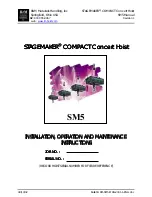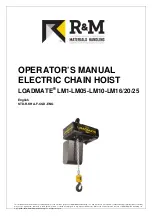
2
ENGLISH
SAFE OPERATING PROCEDURES
Ingersoll Rand
recognizes that most companies who use hoists have a safety program in force in their plants. In the event
you are aware that some conflict exists between a rule set forth in this publication and a similar rule already set by an
individual company, the more stringent of the two should take precedence.
Safe Operating Instructions are provided to make an operator aware of unsafe practices to avoid and are not necessarily
limited to the following list. Refer to specific sections in the manual for additional safety information.
1.
Only allow people, trained in safety and operation of this product, to operate the hoist.
2.
Only operate a hoist if you are physically fit to do so.
3.
When a
“DO NOT OPERATE”
sign is placed on the hoist or controls, do not operate the hoist until the sign has
been removed by designated personnel.
4.
Before each shift, inspect the hoist for wear or damage.
5.
Never use a hoist which inspection indicates is worn or damaged.
6.
Periodically, inspect the hoist thoroughly and replace worn or damaged parts.
7.
Lubricate the hoist regularly.
8.
Do not use hoist if hook latch on a hook has been sprung or broken.
9.
Check that the hook latches are engaged before using.
10.
Never splice a hoist chain by inserting a bolt between links.
11.
Only lift loads less than or equal to the rated capacity of the hoist. See “SPECIFICATIONS” section.
12.
When using two hoists to suspend one load, select two hoists each having a rated capacity equal to or more than the
load. This provides adequate safety in the event of a sudden load shift.
13.
Never place your hand inside the throat area of a hook.
14.
Never use the hoist load chain as a sling.
15.
Never operate a hoist when the load is not centered under the hook. Do not “side pull” or “yard.”
16.
Never operate a hoist with twisted, kinked, “capsized” or damaged load chain.
17.
Do not force a chain or hook into place by hammering.
18.
Never insert the point of the hook into a chain link.
19.
Be certain the load is properly seated in the saddle of the hook and the hook latch is engaged.
20.
Do not support the load on the tip of the hook.
21.
Never run the load chain over a sharp edge. Use a sheave.
22.
Pay attention to the load at all times when operating the hoist.
23.
Always ensure that you, and all other people, are clear of the path of the load. Do not lift a load over people.
24.
Never use the hoist for lifting or lowering people, and never allow anyone to stand on a suspended load.
25.
Ease the slack out of the chain and sling when starting a lift. Do not jerk the load.
26.
Do not swing a suspended load.
27.
Never leave a suspended load unattended.
28.
Never weld or cut on a load suspended by the hoist.
29.
Never use the hoist chain as a welding electrode.
30.
Do not operate hoist if chain jumping, excessive noise, jamming, overloading, or binding occurs.
31.
Do not use the up and down stops as a means of stopping a hoist. The up and down stops are emergency devices
only.
32.
Always rig the hoist properly and carefully.
33.
Be certain the air supply is shut off before performing maintenance on the hoist.
34.
Do not allow the chain to be exposed to extremely cold weather. Do not apply sudden loads to a cold chain.
WARNING LABEL
Each hoist is supplied from the factory with the warning
label shown. If the label is not attached to your hoist,
order a new label and install it.
WARNING
• Do not use hoist for lifting, supporting or
transporting people.



























